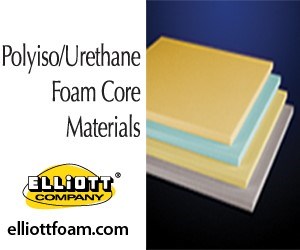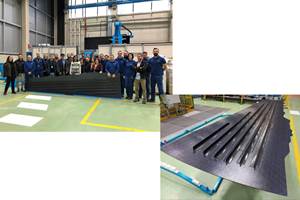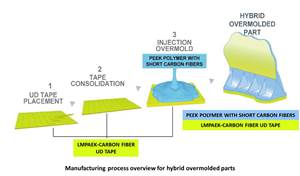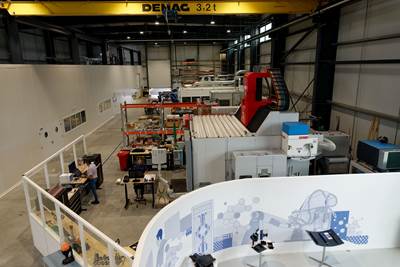“In the oil and gas industry, we drill as deep as the aerospace industry goes high,” says Arash Shadravan, Ph.D., global VP of the Energy Business Unit for polymer additive manufacturing (AM) equipment maker Roboze (Bari, Italy).

Arash Shadravan is part of the Roboze team working to aid adoption of polymer composite materials such as carbon fiber polyetheretherketone (PEEK) in oil and gas manufacturing. PEEK components in oil and gas are often machined from solid. Particularly when the component is large, additive manufacturing (AM) can offer a quicker and cheaper way to obtain the same part.
That equivalence between aerospace and oil and gas manufacturing, as evocative as it is, also hints at other similarities. Dr. Shadravan and I recently spoke about this when I visited Roboze’s North American headquarters in Houston, Texas. For example, both aerospace and oil and gas rely on manufactured hardware that has to perform in demanding applications. Both also rely on manufacturing processes that are subject to well-defined industry standards.
But here is a difference: Aerospace is farther along in its acceptance — that is, in its standards’ acceptance — of AM. But the relatively new (published 2023) American Petroleum Institute Standard 20T, covering “Additively Manufactured Polymer-Based Components for Use in the Petroleum and Natural Gas Industries” (API 20S is the comparable standard for metal), creates a framework for bringing polymer 3D printed parts into oil and gas applications.
That framework is apt to advance one more similarity between aerospace and oil and gas parts. Namely, thanks to 3D printing, we will likely see polymer composites finding greater use in oil and gas components as replacements for what might formerly have been metal parts.

Some of the polymer AM machines running at the Houston Roboze facility are seen here. All these machines are fed by filament material. The company also offers deposition-style AM machines using granulate material.
Shadravan is on the front lines of this in various ways. Formerly of oil producer ExxonMobil and oil and gas equipment maker Baker Hughes before joining Roboze, he cochaired the committee that worked to develop the API 20T standard. (The committee chair, Enzo Savino, nonmetallics principal engineer with oil producer ConocoPhilips, has in mind this company’s needs related to AM.) Meanwhile, the Roboze system Shadravan helps to apply is an example of an industrial 3D printing platform capable of both repeatably producing hardware for oil and gas downhole applications and doing so within the framework of the 20T standard — notably by providing for process traceability.

An example of a large carbon fiber-reinforced PEEK part made more cost-effectively through AM. The fitting is seen here both before and after thread machining. In a video filmed at Roboze's facility, I discuss this part and other examples of 3D printed PEEK parts for oil and gas applications — see below.
Hard, rugged polymer composite materials are already in use for oil and gas components. Carbon fiber-reinforced polyetherether-ketone (PEEK) is a prominent example. This material offers multiple advantages over metal parts, the most notable of which is corrosion resistance surpassing that of even stainless steels. Steel parts needing regular replacement due to corrosion can be given a much longer service life by substituting reinforced PEEK parts. PEEK family materials also provide electrical insulation and lubricity, valuable to downhole (and some surface) equipment applications.
Today, these composite parts are generally machined. That imposes limitations. Obtaining a large billet of reinforced PEEK from which to machine a large component can be challenging, so oil and gas composite parts tend to be either size limited or subject to delay. 3D printing’s advantage for parts such as these invariably involves improved lead time. Here, there is a stark departure from the comparison with aerospace manufacturing. For aerospace, AM routinely involves intricate geometries for complex fluid flow or lightweighting applications peculiar to aircraft. But 3D printing for oil and gas, particularly polymer composite applications, is much more likely to involve geometrically simple components that could instead be machined.

Shadravan discusses with me some of the machine features enabling repeatable 3D printing. One element is visible lower down: a separate material dryer for each of four spools of filament (here, two spools of part material and two spools of support material).
Another feature serving industrial production of critical parts is the traceability report for each build.
Roboze offers polymer deposition 3D printing systems employing both filament and granulate stock. Several features help equip the machine to repeatable production of engineered hardware for downhole applications. A build chamber held to a consistent high temperature suited to the polymer material, combined with a high-performance dryer for (in the case of filament) each material spool, controls for in-process state changes and moisture, two variables that would otherwise affect the form and dimensions of the part as it is being printed. Rack-and-pinion machine motion also aids precision, enabling 0.004-inch tolerances on printed parts, the company says. The frequent result is polymer parts suited for use in their as-printed state. To help validate this, a standard output of the Roboze control is a traceability report documenting relevant process conditions throughout any part’s build. This kind of traceability aligns with API 20T, and it is a requirement of oil and gas manufacturing standards in general.
That said, there is still work to do, says Shadravan — he and others advancing polymer AM in this sector have their work cut out for them. At best, composites are somewhat accepted for oil and gas hardware, and 3D printing less so. When it comes to the latter, he says, many have been disappointed by 3D printed parts in the past, or they associate the term with less robust machines. Another big difference from aerospace is important here: In oil and gas, manufacturing does not necessarily occur in a controlled plant, but often may be in a remote field location. The part thus has to be rugged not just to perform its intended function, but to get to the point of use. Common 3D printed polymers will not do, Shadravan notes.
“The part will have to go to West Texas,” he says. “It has to bake in the sun without melting.” But now, a standards framework, combined with industrialized 3D printing capability for polymer composite components, is bringing a very different possibility. The result is likely to be greater oil and gas adoption of AM and adoption of composites together.
More From This Author
Peter Zelinski reports on the advance of 3D printing for industrial production as editor-in-chief of Additive Manufacturing Media. Find his work in Additive Manufacturing magazine, in The BuildUp newsletter, and on The Cool Parts Show, which he co-hosts. SUBSCRIBE HERE
Related Content
Formula 1 team adopts Roboze 3D printed composites
The Visa Cash App RB Formula 1 team is collaborating with Roboze to reduce weight and create parts with complex geometries via carbon fiber/PEEK.
Read MoreClean Sky 2 OUTCOME project demonstrates PEEK thermoplastic composite wingbox cover
Airbus Defense and Space, FIDAMC and Aernnova demonstrate out-of-autoclave, one-shot process for wingbox cover with integrated stringers for regional aircraft.
Read MoreHitachi Rail chooses Roboze printers, materials including carbon fiber/PEEK for railway spare parts
The Roboze ARGO 500 will be used at Hitachi Rail factories in Naples, Italy and Maryland, U.S. to reduce cost and delivery times for prototypes and spare parts.
Read MoreTool Gauge, Victrex partner to develop co-molded composite aircraft parts
Novel hybrid overmolding technology achieves novel thermoplastic composite parts to replace machined aluminum components on commercial aircraft, as well as reduce manufacturing costs and timeline.
Read MoreRead Next
Roboze supports F1 composite brake cooling duct manufacture
Carbon fiber-reinforced PEEK composites, 3D printing services improve production time and costs of complex motorsport parts for Visa Cash App RB F1 team.
Read MoreComposites end markets: New space (2025)
Composite materials — with their unmatched strength-to-weight ratio, durability in extreme environments and design versatility — are at the heart of innovations in satellites, propulsion systems and lunar exploration vehicles, propelling the space economy toward a $1.8 trillion future.
Read MorePlant tour: Daher Shap’in TechCenter and composites production plant, Saint-Aignan-de-Grandlieu, France
Co-located R&D and production advance OOA thermosets, thermoplastics, welding, recycling and digital technologies for faster processing and certification of lighter, more sustainable composites.
Read More

























